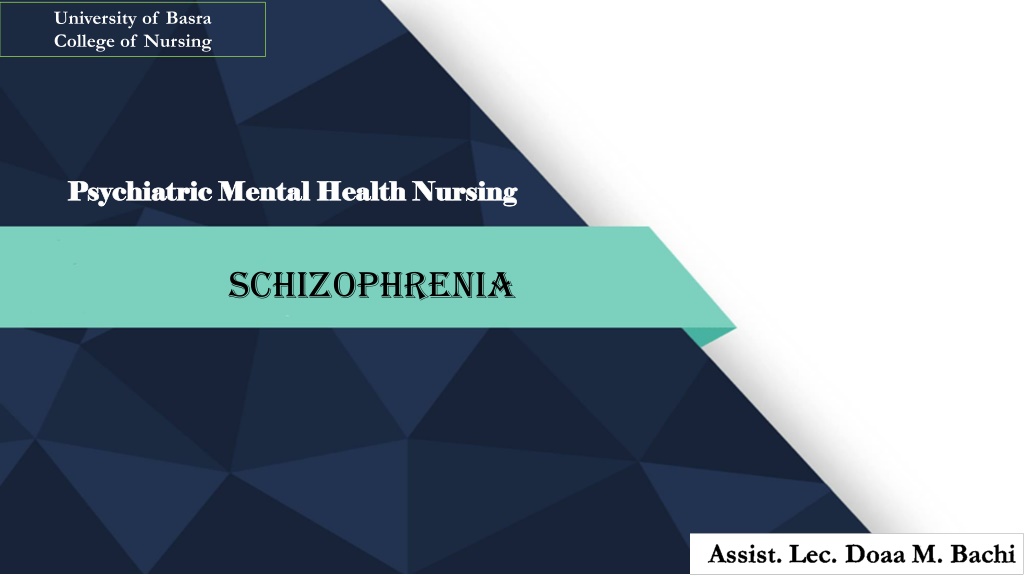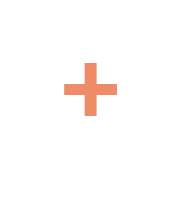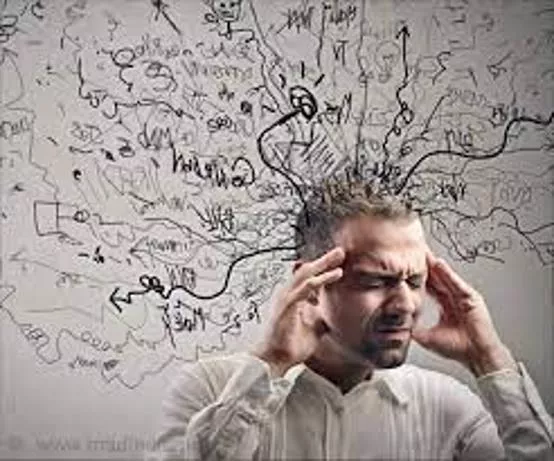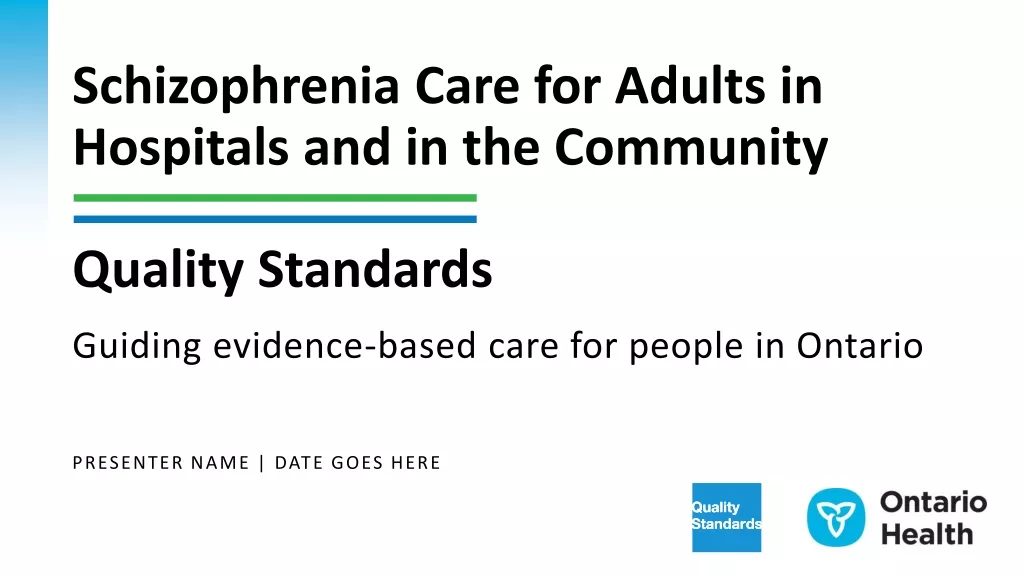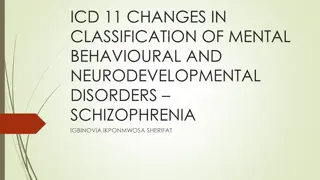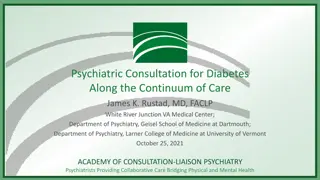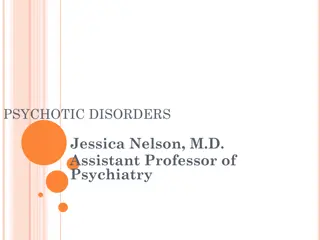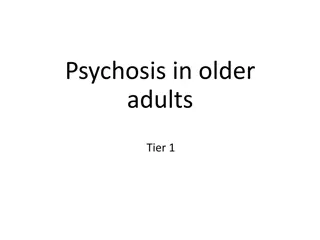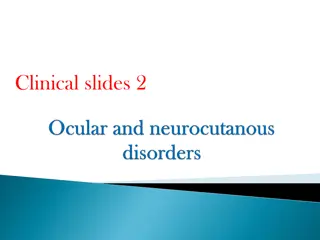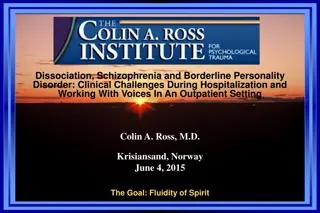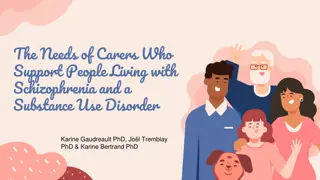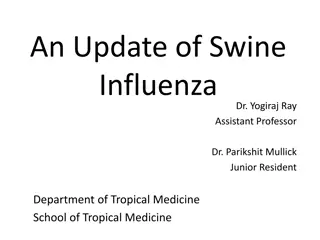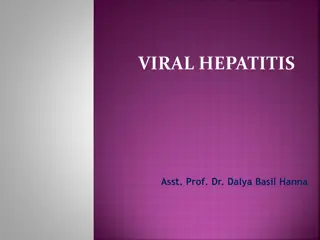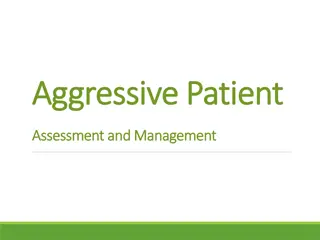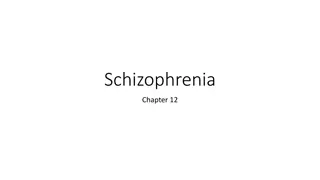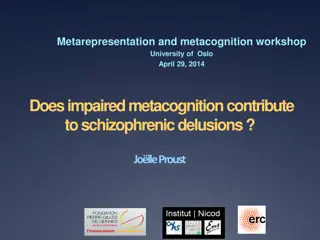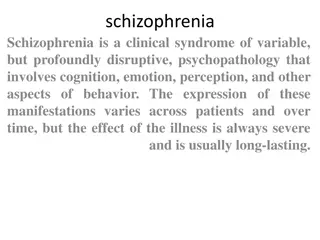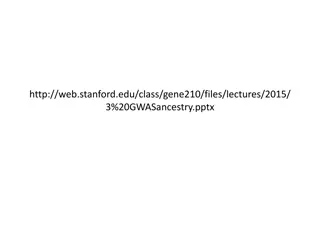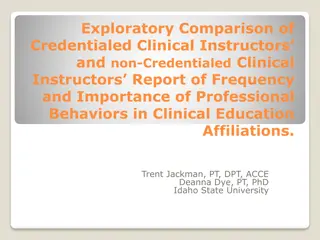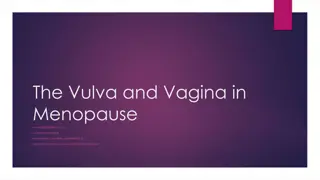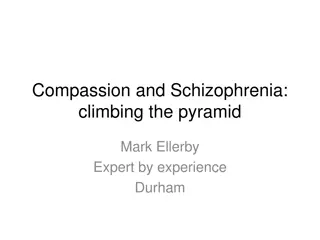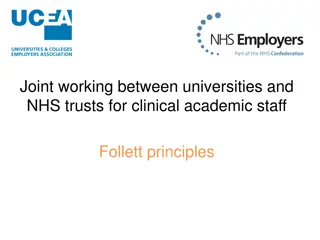Understanding Schizophrenia: Symptoms and Clinical Features
Schizophrenia is a complex mental health disorder characterized by distorted thoughts, perceptions, emotions, movements, and behaviors. It is not a single illness but rather a syndrome with various symptoms, similar to cancer. The onset typically occurs in late adolescence or early adulthood, with peak incidence between 15 to 35 years of age. The symptoms are divided into positive (hard) and negative (soft) categories, including ambivalence, delusions, hallucinations, and bizarre behavior. Different types of delusions, such as persecutory and grandiose, are also common in individuals with schizophrenia.
Uploaded on Jul 22, 2024 | 0 Views
Download Presentation

Please find below an Image/Link to download the presentation.
The content on the website is provided AS IS for your information and personal use only. It may not be sold, licensed, or shared on other websites without obtaining consent from the author. Download presentation by click this link. If you encounter any issues during the download, it is possible that the publisher has removed the file from their server.
E N D
Presentation Transcript
University of Basra College of Nursing + Psychiatric Mental Health Nursing Psychiatric Mental Health Nursing Schizophrenia
+ Schizophrenia causes distorted and bizarre thoughts, perceptions, emotions, movements, and behavior. It cannot be defined as a single illness; rather, schizophrenia is thought of as a syndrome or as a disease process with many different varieties and symptoms, much like the varieties of cancer.
EPIDEMIOLOGY + Schizophrenia is usually diagnosed in late adolescence or early adulthood. Rarely does it manifest in childhood. The peak incidence of onset is 15 to 25 years of age for men and 25 to 35 years of age for women. The prevalence of schizophrenia is estimated at about 1% of the total population
+Clinical Features of Schizophrenia The symptoms of schizophrenia are divided into two major categories: A. Positive Or Hard Symptoms/Signs B. Negative Or Soft Symptoms/Signs
+A. Positive or Hard Symptoms 1. Ambivalence: Holding seemingly contradictory beliefs or feelings about the same person, event, or situation 2. Associative looseness:Fragmented or poorly related thoughts and ideas 3. Delusions:Fixed false beliefs that have no basis in reality 4. Echopraxia: Imitation of the movements and gestures of another person whom the client is observing 5. Flight of ideas: Continuous flow of verbalization in which the person jumps rapidly from one topic to another 6. Hallucinations: False sensory perceptions or perceptual experiences that do not exist in reality
+ 7. Ideas of reference: False impressions that external events have special meaning for the person 8. Perseveration: Persistent adherence to a single idea or topic; verbal repetition of a sentence, word, or phrase; resisting attempts to change the topic 9. Bizarre behavior: Outlandish appearance or clothing; repetitive or stereotyped, seemingly purposeless movements; unusual social or sexual behavior
+Types of Delusions 1. Persecutory/paranoid delusions involve the client s belief that others are planning to harm him or her or are spying, Grandiose delusions are characterized by the client s claim to association with famous people or celebrities, or the client s belief that he or she is famous or capable of great feats. 2. Religious delusions often center around the second coming of Christ or another significant religious figure or prophet 3. Somatic delusions are generally vague and unrealistic beliefs about the client s health or bodily functions 4. Sexual delusions involve the client s belief that his or her sexual behavior is known to others 5. Nihilistic delusions are the client s belief that his or her organs aren t functioning or are rotting away 6. Referential delusions or ideas of reference involve the client s belief that television broadcasts, music, or newspaper articles have special meaning for him or her 7.
+Types of hallucinations Auditory hallucinations:Command hallucinations are voices demanding that the 1. client take action, often to harm the self or others, and are considered dangerous. Visual hallucinations 2. Olfactory hallucinations 3. Tactile hallucinations 4. Gustatory hallucinations 5. Cenesthetichallucinations involve the client s report that he or she feels bodily functions that are usually undetectable 6. Kinesthetic hallucinations occur when the client is motionless but reports the 7. sensation of bodily movement
+B. Negative or Soft Symptoms 1. Alogia: Tendency to speak little or to convey little substance of meaning (poverty of content) 2. Anhedonia:Feeling no joy or pleasure from life or any activities or relationships 3. Apathy:Feelings of indifference toward people, activities, and events 4. Asociality:Social withdrawal, few or no relationships, lack of closeness Blunted affect:Restricted range of emotional feeling, tone, or mood 5. Catatonia: Psychologically induced immobility occasionally marked by periods of agitation or excitement; the client seems motionless, as if in a trance 6. Flat affect:Absence of any facial expression that would indicate emotions or mood 7. Avolition or lack of volition: Absence of will, ambition, or drive to take action or accomplish tasks 8. Inattention:Inability to concentrate or focus on a topic or activity, regardless of its importance 9.
+DSM-5 DIAGNOSTIC CRITERIA FOR SCHIZOPHRENIA Two (or more) of the following, each present for a significant portion of time during a 1-month period (or less if successfully treated). At least one of these must be (1), (2), or (3): 1. Delusions 2. Hallucinations 3. Disorganized speech (e.g., frequent derailment or incoherence) 4. Grossly disorganized or catatonic behavior 5. Negative symptoms (i.e., diminished emotional or avolition)
+ B. For a significant portion of the time since the onset of the disturbance, level of functioning in one or more major areas C. Continuous signs of the disturbance persist for at least 6 months. D. Schizoaffective disorder and depressive or bipolar disorder with psychotic features have been ruled out because either (1) no major depressive or manic episodes have occurred concurrently with the active-phase symptoms or (2) if mood episodes have occurred during active-phase symptoms, they have been present for a minority of the total duration of the active and residual periods of the illness.
+E. The disturbance is not attributable to the physiological effects of a substance (e.g., a drug of abuse, a medication) or another medical condition. F. If there is a history of autism spectrum disorder or a communication disorder of childhood onset, the additional diagnosis of schizophrenia is made only if prominent delusions or hallucinations, in addition to the other required symptoms of schizophrenia, are also present for at least 1 month (or less if successfully treated).
+CLINICAL COURSE A.Onset Onset may be abrupt or insidious, but most clients slowly and gradually develop signs and symptoms such as social withdrawal, unusual behavior, loss of interest in school or at work, and neglected hygiene. schizophrenia is usually made when the person begins to display more actively positive symptoms of delusions, hallucinations, and disordered thinking (psychosis). Younger clients display a poorer premorbid adjustment, more prominent negative signs, and greater cognitive impairment than do older clients.
+ B. Immediate-Term Course In the years immediately after the onset of psychotic symptoms, two typical clinical patterns emerge. In one pattern, the client experiences ongoing psychosis and never fully recovers, though symptoms may shift in severity over time. In another pattern, the client experiences episodes of psychotic symptoms that alternate with episodes of relatively complete recovery from the psychosis.
+ C. Long-Term Course The intensity of psychosis tends to diminish with age. Many clients with longterm impairment regain some degree of social and occupational functioning. Over time, the disease becomes less disruptive to the person s life and easier to manage but rarely can the client overcome the effects of many years of dysfunction. In later life, these clients may live independently or in a structured family-type setting and may succeed at jobs with stable expectations and a supportive work environment.
+RELATED DISORDERS I. Schizophreniformdisorder: The client exhibits an acute, reactive psychosis for less than the 6 months necessary to meet the diagnostic criteria for schizophrenia. If symptoms persist over 6 months, the diagnosis is changed to schizophrenia. Social or occupational functioning may or may not be impaired. II. Catatonia: Catatonia is characterized by marked psychomotor disturbance, either excessive motor activity or virtual immobility and motionlessness. Motor immobility may include catalepsy (waxy flexibility) or stupor. Excessive motor activity is apparently purposeless and not influenced by external stimuli. Other behaviors include extreme negativism, mutism, peculiar movements, echolalia, or echopraxia. Catatonia can occur with schizophrenia, mood disorders, or other psychotic disorders.
+ III. Delusional disorder: The client has one or more nonbizarre delusions that is, the focus of the delusion is believable. The delusion may be persecutory, erotomanic, grandiose, jealous, or somatic in content. Psychosocial functioning is not markedly impaired, and behavior is not obviously odd or bizarre. IV. Brief psychotic disorder: The client experiences the sudden onset of at least one psychotic symptom, such as delusions, hallucinations, or disorganized speech or behavior, which lasts from 1 day to 1 month. The episode may or may not have an identifiable stressor or may follow childbirth.
+ V. Shared psychotic disorder (folie deux): Two people share a similar delusion. The person with this diagnosis develops this delusion in the context of a close relationship with someone who has psychotic delusions, most commonly siblings, parent and child, or husband and wife VI. Schizotypal personality disorder: This involves odd, eccentric behaviors, including transient psychotic symptoms. Approximately 20% of persons with this personality disorder will eventually be diagnosed with schizophrenia
+VII. Schizoaffective disorder: is diagnosed when the client is severely ill and has a mixture of psychotic and mood symptoms. The signs and symptoms include those of both schizophrenia and a mood disorder such as depression or bipolar disorder. The symptoms may occur simultaneously or may alternate between psychotic and mood disorder symptoms. Some studies report that long-term outcomes for the bipolar type of schizoaffective disorder are similar to those for bipolar disorder, while outcomes for the depressed type of schizoaffective disorder are similar to those for schizophrenia. Treatment for schizoaffective disorder targets both psychotic and mood symptoms. Often, secondgeneration antipsychotics are the best first choice for treatment
ETIOLOGY + The causes of schizophrenia is unknown. Biologic Theories The biologic theories of schizophrenia focus on genetic factors, neuroanatomic and neurochemical factors (structure and function of the brain), and immunovirology (the body s response to exposure to a virus). A. Genetic Factors Twin studies: identical twins = 50% risk, fraternal twins = 15% risk. Children with biological parent: One of parent= 15% risk, both parent = 35%
+ B. Neuroanatomic and Neurochemical Factors people with schizophrenia have: 1. less brain tissue and cerebrospinal fluid this could represent a failure in the development or a subsequent loss of tissue 2. Computed tomography scans have shown enlarged ventricles in the brain and cortical atrophy 3. Positron emission tomography studies suggest that glucose metabolism and oxygen are diminished in the frontal cortical structures of the brain. 4. Decreased brain volume and abnormal brain function in the frontal and temporal areas of persons with schizophrenia
+ developed based on two observations: One prominent theory suggests excess dopamine as a cause. This theory was (1) drugs that increase activity in the dopaminergic system, such as amphetamine and levodopa, sometimes induce a paranoid psychotic reaction similar to schizophrenia. (2)drugs blocking postsynaptic dopamine receptors reduce psychotic symptoms More recently, serotonin has been included among the leading neurochemical factors affecting schizophrenia. The theory regarding serotonin suggests that serotonin modulates and helps to control excess dopamine. Some believe that excess serotonin itself contributes to the development of schizophrenia.
+ C. Immunovirologic Factors Cytokines are chemical messengers between immune cells, mediating inflammatory and immune responses. Specific cytokines also play a role in signaling the brain to produce behavioral and neurochemical changes needed in the face of physical or psychological stress to maintain homeostasis. It is believed that cytokines may have a role in the development of major psychiatric disorders such as schizophrenia Recently, researchers have been focusing on infections in pregnant women as a possible origin for schizophrenia. Also, there are higher rates of schizophrenia among children born in crowded areas in cold weather, conditions that are hospitable to respiratory ailments
+TREATMENT A. Psychopharmacology Antipsychotic medications, also known as neuroleptics, are prescribed primarily for their efficacy in decreasing psychotic symptoms. They do not cure schizophrenia; rather, they are used to manage the symptoms of the disease. The conventional or first-generation, antipsychotic medications are dopamine antagonists. The atypical or second- generation, antipsychotic medications are both dopamine and serotonin antagonists The first-generation antipsychotics target the positive signs of schizophrenia, but have no observable effect on the negative signs. The second-generation antipsychotics not only diminish positive symptoms but also, for many clients, lessen the negative signs
+Side Effects of Antipsychotic Medications 1. Extrapyramidal Side Effects. EPSs are reversible movement disorders induced by neuroleptic medication. They include dystonic reactions, parkinsonism, and akathisia. 2. Dystonic reactions to antipsychotic medications appear early in the course of treatment and are characterized by spasms in discrete muscle groups, such as the neck muscles (torticollis) or eye muscles (oculogyric crisis). These spasms may also be accompanied by protrusion of the tongue, dysphagia, and laryngeal and pharyngeal spasms that can compromise the client s airway, causing a medical emergency
3. Tardive Dyskinesia. Tardive dyskinesia, a late-appearing side effect of + antipsychotic medications, is characterized by abnormal, involuntary movements such as lip smacking, tongue protrusion, chewing, blinking, grimacing, and choreiform movements of the limbs and feet 4. Neuroleptic Malignant Syndrome. NMS is a serious and frequently fatal condition seen in those being treated with antipsychotic medications. It is characterized by muscle rigidity, high fever, increased muscle enzymes (particularly, creatine phosphokinase), and leukocytosis (increased leukocytes) 5. Agranulocytosis. Clozapine has the potentially fatal side effect of agranulocytosis (failure of the bone marrow to produce adequate white blood cells). Agranulocytosis develops suddenly and is characterized by fever, malaise, ulcerative sore throat, and leukopenia.
+ Abnormal Involuntary Movement Scale (AIMS) is used to screen for symptoms of movement disorders
+ B. Psychosocial Treatment 1. Individual and group therapy 2. Clients with schizophrenia can improve their social competence with social skill training 3. Cognitive adaptation training using environmental supports is designed to improve adaptive functioning in the home setting 4. A new therapy, cognitive enhancement therapy (CET), combines computer-based cognitive training with group sessions that allow clients to practice and develop social skills 5. Family education and therapy are known to diminish the negative effects of schizophrenia and reduce the relapse rate
+Early Signs of Relapse Impaired cause-and-effect reasoning Low self-concept Ineffective management medication Impaired information processing Poor nutrition Looks and acts different Lack of sleep Hopeless feelings Lack of exercise Loss of motivation Fatigue Anxiety and worry Poor social skills, social isolation, loneliness Disinhibition Increased negativity Interpersonal difficulties Neglecting appearance Lack of control, irritability Forgetfulness Mood swings
